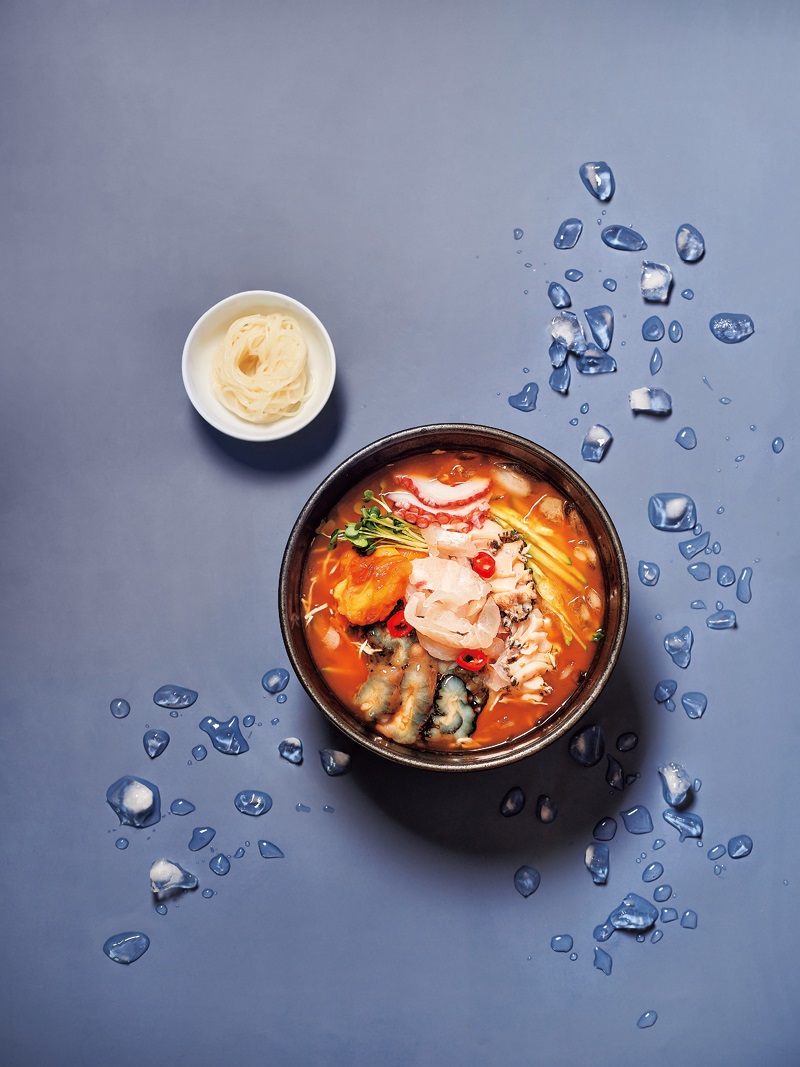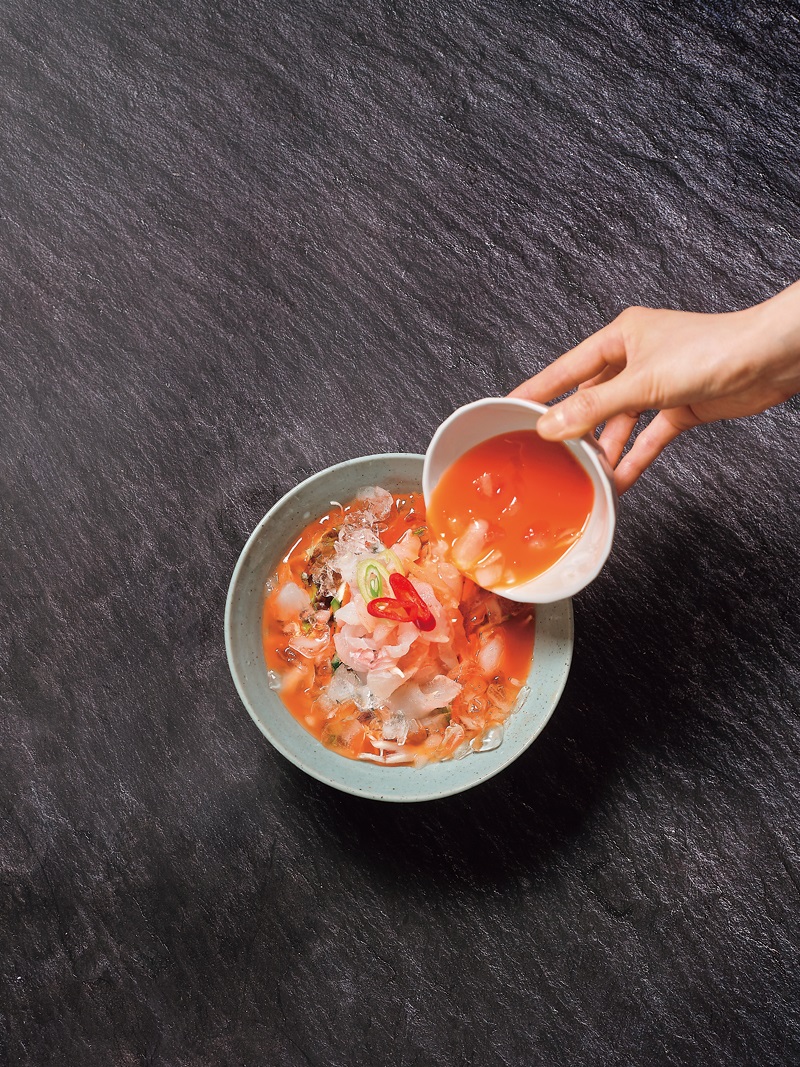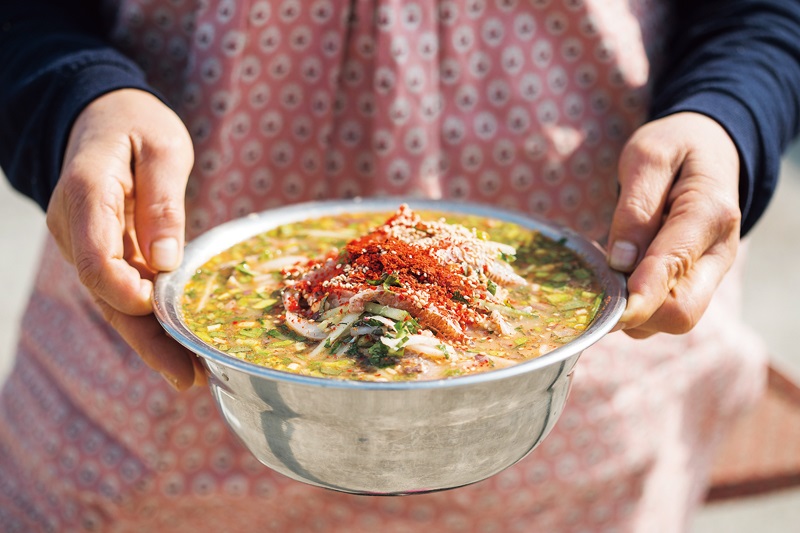물회는 과거 불을 피울 수 없던 목선에서 어부들이 간편하게 만든 뒤 빠르게 먹을 수 있는 패스트푸드였다. 하지만 그 탄생 배경은 그리 가볍지 않다. 밥이 주식으로 하는 오랜 전통, 갓 잡은 생선을 날것으로 먹는 독특한 활어회 문화, 그리고 고추를 발효시켜 만든 고추장이라는 세 가지 조건이 절묘하게 결합되었기 때문이다. 물회는 세계 어디에서도 만날 수 없는 한국만의 독특한 음식이다.
Mulhoe was once a quick and easy meal eaten by fishermen on their wooden boats out at sea, where cooking over fire was not an option. The dish is rooted in Korea’s long-standing tradition of eating rice as a staple food, along with the culture of pairing freshly caught raw fish with gochujang, fermented red chili paste. This combination of factors is what makes mulhoe a uniquely Korean specialty that cannot be found anywhere else in the world.

유엔 식량농업기구(FAO)에서 발간하는 세계수산양식현황(SOFIA)에 따르면 한국의 1인당 해산물 소비량은 매년 세계 상위권을 기록하고 있다. 이는 국토의 삼 면이 바다로 둘러싸인 반도 국가라는 환경 탓도 있겠지만, 이것만으로는 한국의 많은 해산물 소비량은 충분히 설명되지 않는다. 한국보다 더 넓은 바다를 가진 나라도 많기 때문이다.
ACCORDING TO THE BIANNUAL STATE of World Fisheries and Aquaculture report by the UN Food and Agriculture Organization, South Korea consistently ranks among the top nations for per capita seafood consumption. Korea being surrounded by the sea on three sides certainly contributes to this trend but does not explain it entirely. After all, many other countries boast even longer coastlines than South Korea.
해산물 소비가 많은 한국 – A NATION OF SEAFOOD LOVERS
한국인의 해산물 소비량이 매년 세계 순위권에 드는 이유에는 한국인의 독특한 식문화도 한몫한다. 우선 한국인은 김, 미역, 다시마 등 세계에서 가장 다양한 종류의 해조류를 먹는다. 심지어 수출도 많이 한다.
One of the reasons South Koreans love seafood lies in their country’s culinary culture. Korea consumes a wider variety of seaweed than any other nation; this includes gim, miyeok, and dasima — laver, sea mustard, and kelp — as well as many other types of marine plants. The country is also a major exporter of seaweed, with the term used to refer to any plant that grows in the sea.
해조류는 바다에서 자라는 식물이다. 바다에 해조류가 많다는 것은 그만큼 다양한 생물이 사는 건강한 바다라는 증거다. 한반도의 바다는 육지와 가깝고 수심도 너무 깊지 않아 해조류 자생에 좋은 조건을 갖추고 있다. 햇볕이 닿지 않는 너무 깊은 바다나 육지와 멀리 떨어져 무기물이 충분하지 못한 바다에는 해조류가 자생하지 못하기 때문이다.한국인은 예로부터 바다에서 쉽게 구할 수 있는 해조류를 활용해 다양한 요리를 만들었다. 다른 나라에서는 바다의 잡초로 인식되었던 해조류가 한국인에게는 요긴한 식재료였다. 그리고 현대에 와서는 한국인의 건강한 밥상을 구성하는 중요한 요소가 되고 있다.
An abundance of seaweed is evidence of a healthy marine ecosystem teeming with life. Due to their shallow depths and proximity to land, the seas surrounding the Korean peninsula provide optimal growing conditions. Seaweed cannot thrive in deep waters, where it would not benefit from sunlight, or too far away from the shore, where the water contains fewer minerals. Thanks to the relative ease with which it can be harvested, Koreans have used seaweed to all sorts of dishes. This has afforded marine plants a central role in Korean culinary history, and in modern times, seaweed has become an essential component of a healthy Korean diet.
두 번째 이유로는 생선을 익히지 않고 먹는 식문화를 들 수 있다. 아주 오래전부터 지금까지 생선을 날것으로 먹는 방식이 일반화된 나라는 한국과 일본 정도가 유일하다. 서구의 경우 남미(특히 페루)에서 시작된 세비체(ceviche)라는 음식을 통해 생선을 날것으로 먹는 문화가 일부 남아있다. 그런데 세비체는 엄밀히 따지면 생선을 전혀 익히지 않는 것은 아니다. 세비체는 라임이나 레몬에 해산물을 재웠다가 먹는 것인데, 이 과정에서 열 대신 산(acid)에 의해 생선의 표면이 익는다. 날것처럼 보이지만 실제로는 날것이 아닌 셈이다. 이에 반해 한국과 일본은 생선을 비롯한 다양한 해산물을 날것으로 먹는 방식을 오래전부터 이어오고 있으며, 이는 한일 양국 식문화에서 중요한 장르로 굳어졌다. 이렇게 생선을 날것 그대로 먹는 방식을 한국에서는 ‘생선회’, 일본에서는 ‘사시미’라고 부른다.
South Korea’s high consumption of seafood is also tied to the tradition of eating raw fish. This custom is only prevalent in a few countries across the world, most notably South Korea and Japan. In the Western world, such tradition can be seen in dishes like ceviche, recognized by UNESCO as an of traditional Peruvian cuisine, with variations native to other countries along the Pacific Ocean. However, the fish in ceviche is not completely raw but marinated in lemon or lime juice and seasonings, which cures it in a type of cooking process.
In contrast, South Korea and Japan have long embraced the practice of eating fish and other seafood raw, and it remains central to the culinary cultures of both countries. Raw fish is known as hoe in Korea and sashimi in Japan.
복합적인 맛을 즐기다 – COMPLEX FLAVORS
생선을 날것으로 먹는 방식에서 있어 한국과 일본은 뚜렷한 차이가 있다. 일본은 날생선을 손질한 후 충분한 숙성을 거친 후에야 맛볼 수 있는 부드러운 질감과 풍부함 감칠맛을 즐겼다. 숙성을 거쳐 부드러워진 사시미는 밥과 잘 어울렸다. 밥에 식초를 섞어 부패를 방지한 다음 사시미를 얹어 만든 음식이 스시다.
There is a distinct difference between how raw fish is prepared in South Korea and Japan. In Japan, the fish is sliced up and then left for a certain period of time — at least a day — so that it develops a softer texture and more savory taste. Slices of sashimi prepared in this way are often eaten with rice mixed with vinegar, which helps prevent spoilage; this combination is known as sushi.
한국은 생선회를 먹는 포인트가 일본과 달랐다. 숙성된 생선회보다는 사후경직이 진행 중인 생선, 즉 단단한 질감을 선호했다. 대신 다양한 양념과 채소를 곁들였다. 일본이 간장과 고추냉이(와사비) 등 최소한의 소스를 사용해 생선이 가진 본래의 맛을 끌어내는 것에 중점을 뒀다면, 한국은 간장, 된장, 고추장, 참기름, 마늘, 고추 등 다양한 부재료를 곁들였다. 그리고 이 모든 것을 상추나 깻잎 등에 싸서 함께 먹었다. 얼핏 일본보다 덜 섬세해 보일 수 있으나 그렇지 않다. 인간의 미각은 반복되는 행위를 통해 의도된 방향으로 발달한다. 생선과 소스 그리고 채소의 조화를 추구했던 한국인의 미각은 복합적인 맛을 즐기는 쪽을 선호하게 된다. 그래서 사시미를 먹는 일본인의 테이블은 단조로운 반면, 생선회를 먹는 한국인의 테이블은 매우 복잡하고 푸짐하다.
Koreans, on the other hand, prefer freshly prepared fish that retains a very firm texture and is often eaten with assorted sauces and vegetables. While Japanese people mostly limit sashimi condiments to soy sauce and wasabi to emphasize the fish’s flavor, Koreans enjoy hoe with soy sauce; doenjang (fermented soybean paste), gochujang, sesame oil, garlic; and even chili peppers. Lettuce or perilla leaves are often used to wrap the raw fish with one or more of these condiments, and the whole wrap is eaten as one texturally intense and delicious mouthful.
한국 어부의 패스트푸드, 물회 – FISHERMEN’S FAST FOOD
조선시대(1392~1910년)까지 한국의 어업은 나무로 만든 목선과 노를 젓거나 바람을 이용하는 무동력선에 의지했다. 근대 이후 엔진에 의해 움직이는 동력선이 도입되었으나, 선박의 재질이 나무라는 사실에는 변함이 없었다. 동력선이 도입되자 이전보다 훨씬 먼 바다로 나갈 수 있었다. 먼 바다로 나갈수록 조업 시간은 길어졌다. 배에서 식사를 해결해야 했다.
Until the end of the Joseon Dynasty (1392–1910), Koreans used wooden rowing or sailing boats for all ocean fishing. Even after the introduction of motorized vessels, the majority of fishing boats continued to be made from wood. Boats with engines allowed fishermen to venture much further out to sea, resulting in longer journeys that required them to prepare and eat food on board.

한국인의 주식은 전통적으로 쌀이나 보리 등을 익힌 밥이었다. 밥은 곡물의 껍질만 벗겨 낱알 그대로를 익힌 음식이다. 밀이나 메밀을 분쇄해 가공한 분식(粉食)에 비해 조리가 간편하고 영양 손실도 적었다. 하지만 한 가지 단점이 있었다. 쌀과 보리에 함유된 탄수화물은 아주 단단한 구조로 결합 되어 있다. 여기에 열과 수분을 가하면 단단 구조가 깨지면서 부드럽게 변한다. 이를 겔화(gelation)라고 한다. 즉 쌀의 겔화가 진행되면 밥이 된다. 그런데 밥을 상온에 두면 수분이 증발하면서 다시 딱딱해진다.
Traditionally, rice and barley have been the main staples of the Korean diet, often prepared with the grains being dehusked and cooked whole. Compared to flour-based foods made from grains such as wheat or buckwheat, rice is usually far simpler to cook and retains more of its nutritional value. That said, cooked rice easily loses its moisture and returns to a hardened state when left out for too long.
과거 한국 어부의 상황을 한번 상상해 보자. 이른 아침 먼바다로 고기잡이를 떠나면서 밥 한 덩어리를 챙겼을 것이다. 고된 바닷일을 하다 보면 금방 허기를 느끼게 된다. 집에서 가져온 밥은 이미 차갑게 식었고 그냥 먹기에는 딱딱하다. 불을 피워 물을 끓이면 딱딱한 밥을 부드럽게 만들 수 있지만, 나무로 만든 목선에서 불을 피우는 것은 위험한 행위다. 게다가 배 위에서는 여러 가지 반찬을 늘어놓고 여유 있게 식사할 상황이 아니었다. 차가운 물에 밥을 말았고 반찬으로 갓 잡은 싱싱한 생선을 듬성듬성 썰어 넣었다. 여기에 고추장 한 숟가락을 곁들여 밍밍한 맛을 보완했다. 조업 중 잠깐 짬을 내어 밥과 생선회를 물에 말아 그릇째 들고 후루룩 마시듯 먹던 물회는 어부들이 배 위에서 쉽고 빠르게 배고픔을 채우기 위해 고안한 패스트푸드였던 것이다.
Imagine the lives of Korean fishermen of the past. Setting off early in the morning for a day of fishing out in the open sea, they would have packed a large amount of bap, the Korean umbrella term used to refer to cooked rice and other grains, to eat aboard their boats. Their physically taxing labor would soon leave them hungry, but their bap would have just as quickly turned cold and hard, rendering it unappetizing. Boiling it in water could soften it up, but lighting a fire aboard a wooden boat was very risky. Instead, they came up with the idea of soaking it in cold water and adding thin slices of freshly caught fish with a spoonful of gochujang for extra flavor — a substitute for the side dishes they would have enjoyed on land. Thus, mulhoe can be seen as a kind of fast food devised by Korean fishermen that allowed them to revive and enjoy their bap. They could quickly wolf down this easily prepared meal while taking a short break from their strenuous work at sea.
뚜렷한 지역별 특색 – DISTINCT REGIONAL DIFFERENCES
시원한 육수에 싱싱한 횟감의 조화가 일품인 물회는 어부의 음식에서 발전해 오늘날 바다 주변 관광지에서 흔히 만날 수 있는 음식이 되었다. 시원한 육수에 취향별로 고른 횟감과 아삭한 채소, 밥 또는 면을 선택해 후루룩 말아먹는 물회는 무더운 여름을 달래줄 별미가 되었다.
Mulhoe, which is always served cold and enjoyed for its delightful combination of refreshing soup and slices of freshly caught fish, has evolved from a humble fisherman’s dish into a delicacy that can now be found at any of South Korea’s seaside tourist destinations. The appealing flavor and textural balance between the soup, one or more types of fish, crunchy vegetables, and a serving of either rice or noodles has seen mulhoe become one of the most popular summer dishes to beat the stifling heat.
최근에는 몇몇 바닷가 주변에서 관광지 음식으로 입소문이 나면서 소박한 음식으로 출발한 물회는 점점 화려하고 다양하게 변하고 있다. 기본적으로 계절에 따른 생선이나 해산물, 채소 또는 과일을 사용하는 것엔 크게 다를 것 없지만, 한국에서 물회는 ‘물회’라는 하나의 형식만 존재할 뿐 지역마다, 음식점마다 개성이 다른 음식으로 분화하고 있다.
Meanwhile, more elaborate reinventions of mulhoe are gradually gaining in popularity. While its basic ingredients remain the same, the concept of mulhoe itself varies from region to region and even from one establishment to another, with each adding their own twists to a unique interpretation.

강원도 영동지방에서 시작된 일명 강원도 물회는 우리가 흔히 생각하는 이미지의 물회다. 냉수나 차가운 육수에 초고추장과 식초, 설탕 등을 넣어 만든 양념이 더해져 매콤 새콤한 맛이 조화를 이루는 가장 대중적인 맛이다. 횟감으로는 주로 담백한 물가자미 등을 사용하며 강릉에서는 길게 채 썬 오징어를 넣은 오징어 물회도 유명하다. 또 속초에서 시작해 전국 체인을 두고 있는 청초수 물회에서는 활전복, 해삼, 멍게, 문어, 날치알과 계절에 따른 여러 가지 횟감, 사골육수 등이 어우러진 ‘해전물회’ 메뉴가 인기다. 사람들은 이 물회를 맛보기 위해 사시사철 긴 대기시간도 기꺼이 감수한다.
For most Koreans, the type of mulhoe that first comes to mind is the one commonly served in the coastal region of Yeongdong in Gangwon Province. This classic rendition consists of a soup made from either cold water or broth mixed with a tangy and spicy blend of gochujang, vinegar, and sugar. Flounder or a similar type of white fish is commonly used, although nearby Gangneung is famous for a variation including long strips of thinly sliced squid. There is even a nationwide restaurant chain called Cheongchosu Mulhoe, originally hailing from neighboring Sokcho, that specializes in this version. The chain also offers a popular dish called haejeon mulhoe, which consists of fresh abalone, sea cucumber, sea pineapple, octopus, flying fish roe, and a different type of fish depending on the season, all served together in a cold and savory beef broth. Throughout the year, people can be seen lining up to enjoy a taste of this famous mulhoe.
고추장을 베이스로 하는 또 다른 물회에는 포항식 물회도 있다. 이 물회의 가장 큰 특징은 언 육수를 갈아서 슬러시 형태로 그릇에 담는 것이다. 각종 횟감과 야채 위에 팥빙수처럼 수북하게 쌓인 고추장 베이스의 매콤달콤한 육수를 함께 버무려 먹는 방식이다. 동해식 물회가 식초의 맛을 살린 육수라면 포항식 물회의 육수는 고추장의 맛을 살린 진득함이 두드러진다. 얼핏 보이엔 물회보단 비빔회에 가까운 모습이지만, 슬러시 육수 덕분에 식사를 마칠 때까지 시원하게 먹을 수 있다.
Pohang-style mulhoe uses gochujang as the main flavoring agent. This version stands out thanks to its slushy, frozen broth. With its generous topping of gochujang, the dish bears some resemblance to patbingsu, a traditional Korean dessert of finely shaved ice adorned with red bean paste. Pohang-style mulhoe offers a sweet and spicy taste, a contrast to Gangwon Province’s vinegary flavor. While this version may resemble bibimhoe, a similar dish without any broth, the slushy soup ensures that it remains cool until the last mouthful.
다른 지역의 물회가 대부분 고추장을 기본으로 하는 육수를 쓰는 반면, 제주도에서는 된장을 사용한 육수를 썼다. 지리적인 특성으로 고추가 귀했기 때문이다. 물회뿐만 아니라 전반적으로 고추장보다는 된장으로 맛을 내는 음식이 많다. 주로 자리돔을 넣은 자리물회가 유명하다. 된장으로 양념한 물회에 제피나무 잎을 약간 넣어 특유의 향을 살리고 생선 비린내를 없앴다. 또 톡 쏘는 빙초산 한 방울을 넣은 뒤 보리밥을 말아서 먹었다. 뼈째 썰어 투박하지만, 담백한 회와 구수한 된장의 조화가 돋보이는 제주 물회는 육지와는 전혀 다른 특징과 매력을 보여준다.
On Jeju Island, mulhoe has traditionally been prepared with a broth made from doenjang. This can be attributed to the fact that chili peppers have historically been scarcer on the island due to its geographical conditions. As a result, the majority of dishes on Jeju Island use doenjang over gochujang as the primary flavor base. The most famous type of Jeju mulhoe is made with a fish called jaridom, or pearl-spot chromis. Prickly-ash leaves are sometimes added to the soup to impart a unique fragrance, which helps minimize the fishy aftertaste. Jeju mulhoe is often eaten mixed with barley rice, while a small drop of glacial acetic acid is also added before serving to give the dish a tangy flavor. Thanks to the mild taste of the fish and the savory doenjang, Jeju mulhoe delivers a particularly harmonious combination of flavors.
이처럼 계절과 지역에 따라서 서로 다른 생선을 사용하고, 고추장에 설탕, 참기름, 식초, 콩가루 등을 더해 특별한 소스를 만들기도 하고 물 대신 전용 육수를 만들어 사용하는 곳도 늘고 있다. 이러한 다양성 때문에 저마다 ‘물회의 원조’라고 주장한다. 하지만 물회는 그 어느 곳도 원조가 아니면서, 그 모든 곳이 원조가 될 수도 있는 미스터리한 음식이다. 이것은 한국 음식이 갖는 중요한 특징이기도 하다. 멀리서 보면 단조로워 보이는데 알면 알수록 복잡하고 섬세하다. 아무튼 한국의 여름은 물회가 있어 행복하다.
Contemporary mulhoe dishes are prepared using different types of fish depending on the season and region, along with special sauces containing ingredients such as gochujang, sugar, sesame oil, vinegar, and soybean flour. Additionally, an increasing number of establishments have started using their own specially made broths instead of using water. The existence of so many different varieties has led to each region of Korea claiming to be the birthplace of mulhoe. It is precisely the absence of a definitive place of origin, however, that makes it such a culinary mystery, a characteristic shared by many other quintessentially Korean dishes. While it may appear humble at first glance, a closer look reveals a depth of complexity and nuance. One thing is certain: The hot and humid Korean summer would not be the same without it.
박상현(Park Sang-hyun 朴相泫) 맛칼럼니스트
이민희(Lee Min-hee 李民熙) 사진작가
Park Sang-hyun Food Columnist
Lee Min-Hee Photographer
